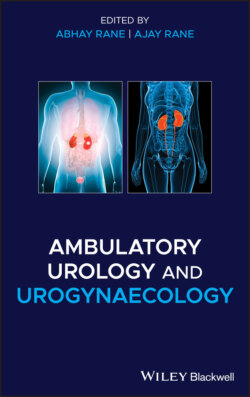Читать книгу Ambulatory Urology and Urogynaecology - Группа авторов - Страница 47
Level II Support
ОглавлениеThe fascial attachment in the mid‐vagina extends from the lateral vaginal walls to the ATFP anteriorly and arcus tendineus rectovaginalis posteriorly. It maintains the midline position of the vagina directly over the rectum and prevents the descent of the anterior and posterior vaginal walls with increased intra‐abdominal pressure. The ATFP shares the same origin as ATLA at the ischial spine. However, it traverses infero‐medially to the ATLA before it inserts on the inferior aspect of the superior pubic rami over the origin of the puborectalis muscle. This explains the normal axis of the upper vagina, as the axis of both ATLA and ATFP are nearly horizontal in a standing woman (Figure 2.5). The endopelvic fascia blends with the vaginal muscularis anteriorly, the rectal muscularis posteriorly, and the perineal body inferiorly. The arcus tendineus rectovaginalis is approximately 4 cm in length and changes the axis of the distal vagina towards the vertical.
The endopelvic connective tissue also extends as pubourethral ligaments, from the urethra to the posterior surface of the pubic bone, providing urethral support and maintenance of bladder neck closure during Valsalva manoeuvres. The bladder neck through its relation to the anterior vaginal wall is also indirectly supported by its attachment axis. Hence, failure of level II support leads not only to anterior and posterior vaginal wall prolapse but may also lead to SUI.
The differentiation between a ‘central cystocele’ and a ‘paravaginal defect’ in anterior compartment prolapse is based on the type of endopelvic fascia deficiency. In central cystocele (distension cystocele), there is weakening of the connective tissue in the midline, resulting in the loss of midline rugosity of the vaginal wall. A lateral cystocele or paravaginal defect results from lateral detachment of the fascia from the ATFP, and the central rugosity is preserved in these. Prior to surgical intervention, it is important to identify the type of anterior wall prolapse as either a lateral detachment or central defect in order to plan the optimal surgical technique.
Figure 2.5 The lateral attachments of the pubocervical fascia (PCF) and the rectovaginal fascia (RVF) to the pelvic sidewall. Also shown are the arcus tendineus fascia pelvis (ATFP), arcus tendineus fascia rectovaginalis (ATFRV) and ischial spine (IS).
